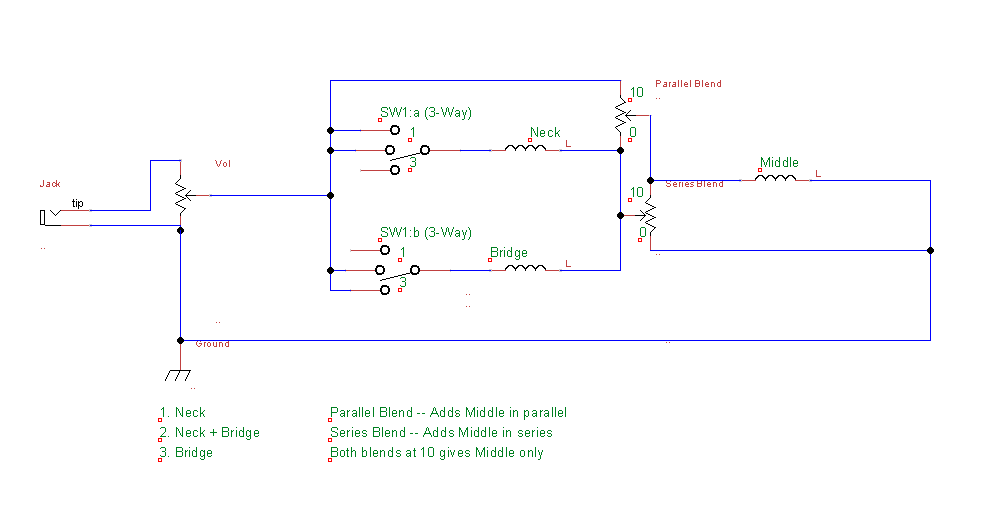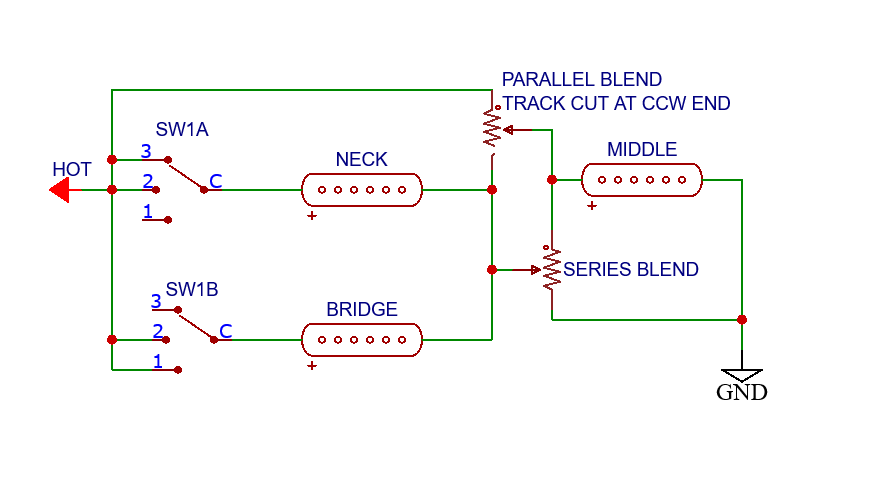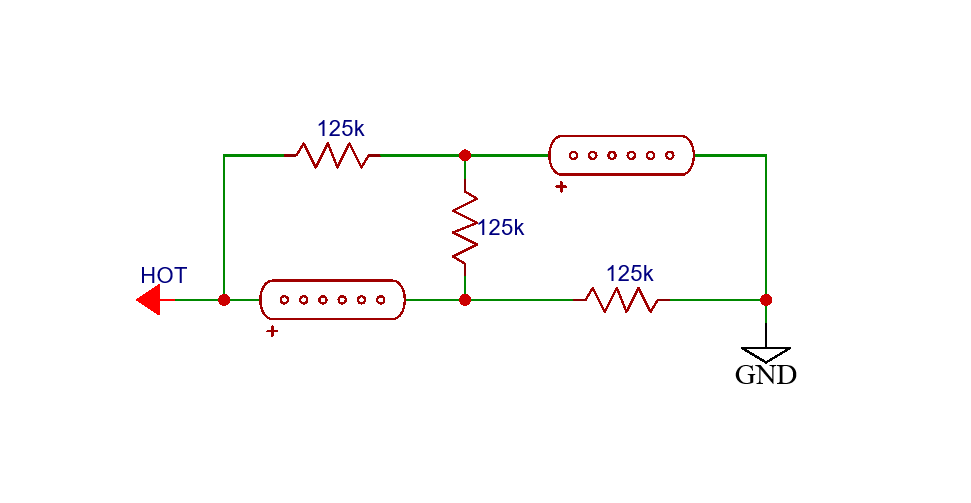|
|
Post by jhng on Dec 22, 2021 8:21:29 GMT -5
Hello all, I'm looking at a possible SSS setup using a three-way switch and two blenders as set out below. The three-way selects B, B+N, N. One blender brings in the Middle pickup in parallel (I think older Nashville Tele's were wired like that?). The second blender brings in the Middle pickup in series. When both blenders are at 10 you have the middle pickup only. So effectively, once the Middle pickup is blended in fully (either series or parallel) the other blender then blends out the N/B side. It should work nicely when the blenders are at either 0 or 10. However, I was also wondering if anyone had any thoughts about how useful (or rubbish) the in between positions would be, particularly when both blenders are operating together? Also, which way around would it be best to do the log tapers? I've looked at the very helpful threads on series blending by JohnH but I don't think he addressed tapering much in that context. It may be that this is case where you simply have to build it and see what happens...  |
|
|
|
Post by newey on Dec 22, 2021 8:52:19 GMT -5
I don't have an answer as to tapers or how useful the in-betweens may be. But I throw this out as I don't know if you saw this idea from ChrisK, using a 2-gang blend pot with a DPDT to select between series blending and parallel blending: guitarnuts2.proboards.com/thread/3863/series-parallel-blend-dpdt-switchThis could solve any issues with the blenders acting together. While shown as a blend of 2 pickups, it could just as easily blend one pickup plus the 3-way switch. The middle alone would be unavailable, though, without another switch or perhaps with using an On-On-On DPDT. Just a thought, anyway. |
|
|
|
Post by reTrEaD on Dec 22, 2021 9:58:00 GMT -5
It may be that this is case where you simply have to build it and see what happens... I think we can do a reasonable analysis on paper. With both pots on 0, the middle pickup is out of the circuit and the full resistance of the parallel pot is loading whatever is selected by the pickup switch. Necessarily this demands the parallel pot be a rather large value, similar to what you would use for a volume or tone control. With the series pot at 0 and the parallel pot at 10, the middle pickup is directly in parallel with whatever is selected by the pickup switch. The full resistance of both pots is loading the circuit. Not wonderful but not really a deal-breaker. When the parallel pot is rotated CCW from 10, the resistance in series with the middle pot quickly becomes a factor. It doesn't take much resistance to severely reduce the contribution of the middle pickup. For this reason, the parallel pot should be RA. OR the pot could be audio taper with the ends exchanged such that 0 is CW and 10 is CCW. Once the resistance in series with the middle pickup becomes appreciable, say 25k, the middle pickup's contribution isn't much a factor but the loading on whatever is selected by the pickup switch is severe. It becomes a tone-suck. You'll find the best results when the middle pickup is fully in parallel, mostly in parallel with a small series resistance, or fully dialed out of the mix.
With the parallel pot at 0, rotating the series pot clockwise will quickly add another path for whatever is selected by the pickup switch. ie: the middle pickup. In my opinion, better results could be had if the wiper and CCW end of the series pot are connected together. But ... this would preclude the possibility of using the middle pickup alone. (see below)
With both pots at 10, the middle pickup is the only one providing signal. The full resistance of both pots is loading the middle pickup.
With both pots in the middle of their rotation, things get seriously wonky. There is serious loading of the pickups but significant series resistance.
Also, I reckon you'll want to wire your volume control the other way round. With the wiper to the tip of the jack and the CW to the pickup switch.
Anyway, that's my take on it. But I'll defer to JohnH , if/when he decides to weigh in. |
|
|
|
Post by jhng on Dec 22, 2021 14:28:26 GMT -5
Thanks newey, reTrEaD. Helpful comments. And reTrEaD is quite right that I've got the volume the wrong way around -- thanks for flagging that. The weird interaction with both blenders at 5 is the critical question. If that setting is useful, or at least not awful, then the whole setup may have some merit. However, if it is totally rubbish and means that the blenders are only really useful as glorified switches, then I probably need to rethink the whole idea. I worked out that in the 5/5 position the circuit between two pickups (Middle and B or N) is as shown below (the second version simplifies the two resistors in parallel). I'm not sure how this would sound, but my gut feeling is not good. You've got some resistance in series which will lose a bit of top-end, plus a 125k bypass on each pickup that will presumably cost some signal. I tried to work out if I could simulate this in GuitarFreak, but I think it may be too bizarre.  |
|
|
|
Post by JohnH on Dec 23, 2021 8:05:16 GMT -5
Its a tricky one, that uyou may have to build.
For parallel blending, like mixing pickups on a normal LP, log pots will go from a full mix when both both are at 10, down to one almost removed at 9, if the other is at 10. Log is great for volume, but for blending, a reverse log, or at least a linear pot, may be better. Series blending, a normal log is good.
This is outside of what GuirarFreak can do. It'll do a good job with full mixes, but it can't currently do blending of pickups, except as a simple full blend. To do that would need two full set of code, one for each pickup, then combine Ill do it one day! but a Spice model would be easy enough.
|
|
|
|
Post by MattB on Dec 23, 2021 10:23:53 GMT -5
I'm wondering if it would be possible to use a parallel blend pot with the track cut at the CCW end to make a kind of reverse no load pot? Like this:  Witht the track cut, the parallel blend pot isn't adding any extra load to the circuit. If I'm understanding this correctly, that means you could use a smaller valued pot and have the useful range of sounds spread out across the full sweep of the knob, instead of confined to one end.
I think both blenders will work fine individually with this setup, and should sound better without the parallel blender loading the circuit, but I'm not sure about using both in combination. This is what I think the circuit simplifies down to with both blenders at 5:
 I have no idea if that would sound any better or worse than the original version, but maybe it could be different enough to be worth a try? I'm far from an expert at this kind of thing , so maybe there's some major downside to the idea that I'm not seeing, but as far as I can tell it should at least be functional.
|
|
|
|
Post by jhng on Dec 23, 2021 10:27:22 GMT -5
Thanks, John. That's really helpful on the tapers. It sounds like it would make more sense to have 0 as the parallel end for both blend pots and 10 as the series end. So 10/10 is both sides in series while 0/0 is both sides in parallel, with 10/0 and 0/10 being Middle only or N/B only. Then the thin end of the pots does the parallel blending and the thick end does the series blending.
Incidentally, Guitarfreak is any amazing piece of kit and must have been a huge amount of work to build. Very impressive.
|
|
|
|
Post by jhng on Dec 23, 2021 10:35:38 GMT -5
I'm wondering if it would be possible to use a parallel blend pot with the track cut at the CCW end to make a kind of reverse no load pot? Like this: Witht the track cut, the parallel blend pot isn't adding any extra load to the circuit. If I'm understanding this correctly, that means you could use a smaller valued pot and have the useful range of sounds spread out across the full sweep of the knob, instead of confined to one end. Thanks, that's a helpful idea. In fact, the track wouldn't even need to be cut, I'd just leave that bottom lug open. It would mean that the series blender functions as a voltage divider rather than a bypass, but that should still work okay. |
|
Deleted
Deleted Member
Posts: 0
Likes:
|
Post by Deleted on Dec 23, 2021 13:28:58 GMT -5
What if you used a center tap pot
Basically the middle of the resistance track is tapped to one leg
So have N and B hooked to the center tap
M hooked to both rotary arms
One side of the pot to ground and another to output
Just some thing crossing my mind!
|
|